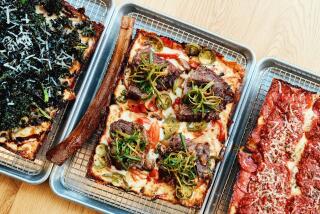A pizza parlor in your kitchen
It didn’t hit me until I was loading firebrick into the back of my clean car one Sunday afternoon that maybe my little “project” was turning into more of an obsession.
All I wanted was a really good homemade pizza.
There are many components that go into a great pizza, and opinions vary as to what they are. But any pizza lover will agree that you can’t bake one without a super-hot oven, and you can’t replicate the effects of a great pizzeria oven with a standard home model -- even with a pizza stone or ceramic tiles. A home oven simply can’t reach the right temperature or mimic the necessary radiant heat.
Short of remodeling your kitchen or constructing a wood-fired brick oven in your backyard (that’s assuming you have a backyard, and the necessary permits), great homemade pizza is just not going to happen at home. You’re better off keeping your favorite takeout number on speed-dial when you’re craving a great pie in the sweet comfort of your living room.
At least that’s what I’d always thought. Boy, was I wrong.
For about $15 worth of brick and a few ceramic tiles or a pizza stone, even great pizza is possible at home. That and a bit of an odyssey -- well, for me at least.
It all started when I was lamenting my pizza pipe dream to my friend David, a passionate bread baker, and he mentioned his HearthKit, a ceramic insert he purchased several years ago for baking at home. A large rectangle similar to a pizza stone, the insert sits on a rack, or the floor, of a standard home oven with two curved ceramic walls that come up either side about six inches. The insert absorbs the intense heat from the oven, and then radiates it back onto whatever is baking, mimicking the effects of the ovens used by professionals. Unfortunately, the company’s website is being retooled, and a call to a company representative confirmed that HearthKits are currently unavailable.
Then David brought up firebricks as a possibility. See, David is one of those guys who actually has plans to build a brick oven in his backyard (if I’m obsessed, he’s more so), and he’s done a lot of research on both ovens and bricks. We discussed firebricks, and they sounded promising. Excited, I told David I would investigate and report back.
Which brings me back to Sunday afternoon. I spent half the weekend casually looking for firebrick, mistakenly thinking it would be readily available at any major hardware store. It’s not. And you can’t substitute just any brick -- you need brick that’s been fired at an extremely high temperature to withstand the consistent heat of an oven. Firebrick, made to line fireplaces and chimneys, fits the bill.
Needed: firebricks
By Sunday, I’d had the sense to contact a fireplace store, which referred me to a masonry supply yard. Only one yard was open that day, way across town, but one 45-minute drive later, I was happily loading firebrick into my car.
Firebricks in hand, I began constructing an insert in my oven. The first attempts were horrendous, even potentially catastrophic. On my first try, I used thick, 7 1/2 -pound bricks, and the assembled insert weighed more than 90 pounds. I quickly removed them, worried that I might permanently damage the oven (I swear I could hear it groaning under all the weight).
Split firebricks worked better. They are the same length and height, but thinner and half the weight. But the sides were precariously balanced, and I was afraid the thinner bricks might slip through the oven rack.
So I contacted Clark Staub, chef and owner of Full of Life Flatbread in Los Alamos, Calif. A professional baker with a background in artisanal breads, he has created different oven configurations to manipulate different types of heat, including the one in the center of his restaurant. I e-mailed him pictures of some of my attempts and we talked.
Staub liked what he saw but suggested tweaking a few things. We decided to use a regular pizza stone as the base of the insert; it’s lighter than a base made of firebrick but will still absorb and radiate the heat necessary to set the crust. I then placed two thick firebricks on either side of the pizza stone to act as walls; they would absorb and radiate heat as a pie baked.
Radiant heat
Finally, I built a low “ceiling” out of split firebrick on the upper rack in the oven to create a small, enclosed chamber that would allow the heat to radiate downward over the entire pizza for intense, even baking.
Fingers crossed, I cranked the oven to its highest setting (550 degrees) and waited. It took a good hour, but the oven and bricks became scorching hot. This looked promising.
Now, the foundation to any great pizza is the crust, so the next step was developing the dough. A good crust has to set up and bake quickly in a hot oven, it should be crisp on the outside but tender and slightly chewy on the inside. And it has to carry good flavor without drawing too much attention to itself. The best pizza crusts are the ones you notice only after you’re done eating.
The secret? Start with a moist dough. Artisanal bread expert Peter Reinhart recommends a well-hydrated dough that makes a crust with a light, airy texture, and the moisture keeps the crust from drying out in a super-hot oven. Some of the best recipes call for two-thirds or more the amount of liquid to flour in the dough.
It’s also important to use only a small amount of yeast. The trick is to add just enough to get the dough started, then set the dough aside for several hours or even overnight, to give the yeast time to do its work slowly. This gives the crust depth of flavor.
And while some purists may frown on their use, sugar and oil help too. A little sugar will help activate the yeast and give the crust deeper color.Oil adds richness to the crust and keeps the structure of the dough from toughening too much when it’s kneaded.
The sauce is also key to a great pizza. The trick is to not overdo it. You want a nice, thin layer of basic sauce (and your sauce can be any color; it doesn’t have to be red). Too much and you run the risk of a soggy crust.
Your sauce can be simple. For a quick red sauce, purée a can of chopped tomatoes with a little fresh oregano, basil and garlic. Give the sauce a little depth with some chopped Kalamata olives and season with just a little salt. And don’t worry about cooking it -- your sauce will cook as the pizza bakes.
Red sauce not your thing? Try a white sauce -- it’s easy to make and is a great start for a number of flavorings. Add caramelized onions, deglazed with a little white wine, or try mushrooms or even spinach. You can also use pesto as a sauce, or purée some vegetables (try an eggplant or butternut squash sauce). Or leave the sauce out completely and let the toppings speak for themselves.
Then think cheese. Good fresh mozzarella is not hard to find, but the classic pizza cheese, the one that oozes slightly and gives you that glorious string, is simple, low-moisture mozzarella, available at any grocery store. Or be creative with other cheeses; try Fontina, blue or fresh goat cheese.
Lastly, top your pizza, but keep it simple. With all the work you’ve put into creating your pizza (and your oven), you don’t want to ruin things by overdoing the toppings. Remember, the more toppings you add, the more time it will take for your pizza to bake, and this is bad for the crust. Go with quality ingredients -- less is more -- and keep the toppings simple.
The first test
Fingers crossed, I baked that first pizza. In less than two minutes, the crust had puffed and set, and in only 6 1/2 , the pie was done. The crust was crisp and a rich golden-brown, and when I opened the oven, the smell of tomatoes and herbs was amazing. I waited a minute, then sliced -- the crust was light and airy around the rim, and it snapped as I cut the pie.
Now, for the real test, I bit into a slice. The red sauce had thickened slightly and had a gentle tang, complementing the richness of the melted cheese. The crust was crisp on the outside, yet airy and still a bit chewy. The flavor was gentle but complex and perfectly seasoned. This was one of the best pies I’d ever had.
More to Read
Eat your way across L.A.
Get our weekly Tasting Notes newsletter for reviews, news and more.
You may occasionally receive promotional content from the Los Angeles Times.









